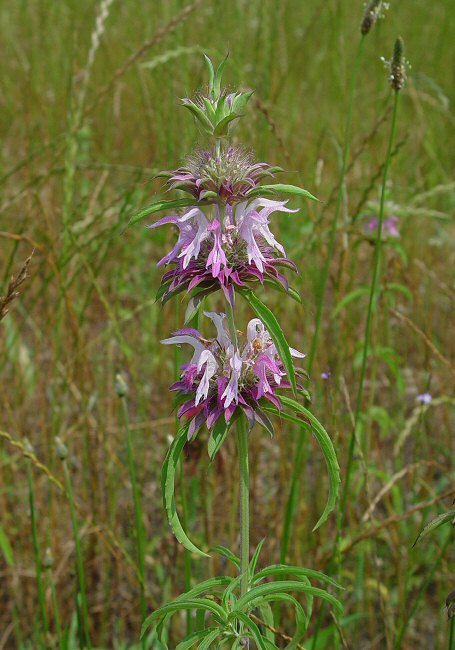Monarda citriodora Cerv. ex Lag.
Lemon Mint

Native
CC = 8
CW = 5
MOC = 21
© DETenaglia
Monarda citriodora Cerv. ex Lag.Lemon Mint | |
 |
Native CC = 8 CW = 5 MOC = 21 |
© DETenaglia |
|
Family - Lamiaceae Habit - Annual forb. Stem - Ascending to erect, to 80 cm long, usually branched, moderately to densely pubescent with minute, downward-curved hairs.
Leaves - Mostly short-petiolate, the petioles 2-20 mm long, the median and upper foliage leaves the largest. Leaf blades 2-6 cm long, lanceolate or oblong-lanceolate, angled or tapered at the base, tapered to a sharply pointed tip (often with a bristlelike extension of the midvein), the margins with moderately to widely spaced, fine teeth, also minutely hairy, the upper surface glabrous or sparsely pubescent with minute, curved hairs, the undersurface glabrous or more commonly sparsely to moderately pubescent with minute, curled hairs, both surfaces with conspicuous impressed glands.
Inflorescence - 2-6 flower clusters forming an interrupted terminal spike, the bracts 15-35 mm long, oblong-elliptic to oblanceolate, with a bristlelike extension of the midvein at the tip, the margins entire or occasionally finely toothed toward the tip, hairy, the upper surface densely pubescent with minute, sometimes purplish hairs, usually strongly pinkish- or purplish-tinged, the undersurface sparsely to moderately and minutely hairy. Innermost bracts 6-10 mm long, linear, the margins hairy.
Flowers - Calyces 9-18 mm long, the outer surface moderately to densely pubescent with minute, curled hairs, densely bristly-hairy in the throat, the lobes 4-7 mm long, narrowly triangular and bearing a prominent, bristlelike extension of the midnerve. Corollas 15-28 mm long, white to pink or pinkish purple, the lower lip often with purple spots or lines, moderately pubescent with fine nonglandular hairs externally, also dotted with sessile glands, the lips lacking longer, denser hairs, hairy in the throat, slightly shorter than the tube, the upper lip strongly arched downward, the lower lip 3-lobed with a pair of short lateral lobes, the central lobe sometimes with a few fine teeth along the margin. Stamens not exserted from the corolla, hidden under the upper corolla lip.
Fruits - Dry schizocarps, separating into usually 4 nutlets, these 1.5-2.0 mm long, oblong-obovoid, the surface yellowish brown, glabrous. Flowering - May - August. Habitat - Prairies, glades, ledges, and tops of bluffs, savannas, forest openings, roadsides, open disturbed areas. Origin - Native to the U.S. Lookalikes - Broadly, other species of Monarda and Blephilia. Other info. - This attractive species is not common in Missouri, being found from a few scattered counties mostly in the southern half of the state. It is most common in the southwestern corner, where the populations are considered native. Elsewhere in the state it is probably introduced, as it is a commonly cultivated plant. Its natural range in North America is in the south-central U.S. and extends into Mexico. Photographs taken off Moores Mill Road, Lee County, AL., 5-21-05 (DETenaglia); also at Klondike County Park, St. Charles County, MO, 7-30-2016 (SRTurner). |